Popping Cork Rig For Inshore Fishing (Quickstart Guide)
UPDATED 03 NOVEMBER 2023
by Robert Ceran
Using a popping cork is not only an incredibly fun way to catch fish, but is also extremely effective.
In fact, the popping cork rig is one of the best inshore fishing rigs for catching redfish or speckled trout.
But rigging a popping cork is not as simple as you may think, since subtle differences in rigging and presentation can make a big difference on the water.
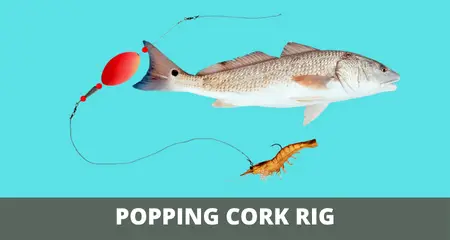
In this article we’ll cover the details of how to set up a popping cork rig correctly, and we’ll also discuss the best ways to use it effectively.
What is a popping cork (and what does it do)?
A popping cork is a bobber threaded onto a metal wire, with a lead weight or several brass beads rigged below the cork, and plastic beads rigged above the cork.
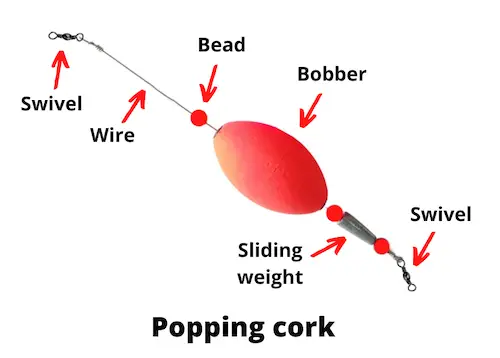
The advantage of this design is that the beads of a popping cork make a rattling and popping sound every time the popping cork is jerked at the water surface during retrieval.
These rattling sounds can be very effective at attracting fish (especially when fishing in murky water), causing them to come closer in order to investigate the sounds.
And when the fish come closer, they’ll find your bait rigged right underneath the cork.
Since popping corks are usually fixed to the fishing line, they are most often used in shallow water between 2 and 6 feet depth.
However, popping corks can also work well in any situation where fish are feeding close to the water surface, and they can even attract fish that are in deeper water to come up to the surface in order to investigate the commotion created by the rattling and splashing sounds.
How to make a popping cork rig
In order to rig a popping cork, you’ll need the following components:
- Spinning setup (7 foot rod with 4000 size reel)
- 20 to 30 lb test braided main line
- 20 to 40 lb test fluorocarbon or monofilament leader line
- Popping cork
- Jig head or circle hook
- Split shot weight (optional)
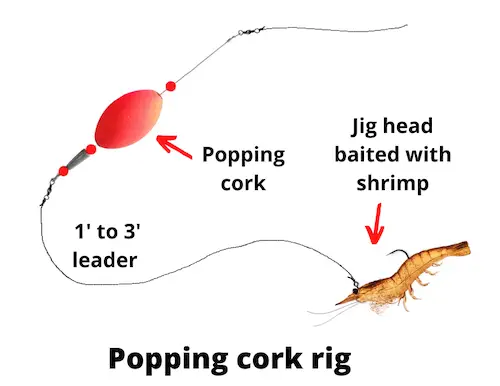
Start by tying your main line to the top swivel of the popping cork with a palomar knot or a single uni knot. The top end is the one that has plastic beads, but no weight or brass beads, which should always go on the bottom.
Next, tie your leader line to a 1/16 to 1/2 oz jig head. The weight of the jig head depends on the size of the bait you want to use, and how fast you want it to sink down in the water column. I usually use a 1/8 or 1/4 oz jig head, which covers most applications.
Following this, measure out the length of leader material that you need, and tie the other end of the leader to the bottom swivel of the popping cork.
If you’re using a jig head, bait it with an artificial shrimp, a live shrimp, or a chunk of cut blue crab, and you’re ready to start fishing.
How long of a leader should you use on a popping cork rig?
The length of your leader depends on the depth of the water that you’re fishing.
In general, it’s best to start by presenting your bait the middle of the water column, and then adjust the depth depending on the results you get.
For example, if you’re fishing in 5 foot deep water, set your leader length to about 2 to 3 feet, and then adjust it if necessary.
Types of popping corks
There are four main types of popping cork:
- Oval/egg shaped
- Cigar shaped
- Cupped
- Adjustable
Let’s take a quick look at each of these, and what advantages they provide.
The most commonly used style of cork is the egg shaped popping cork. This is an ideal shape for fishing with a wide variety of baits that can be rigged with a jig head, and is the most common choice of many anglers.
The cigar shaped popping cork has the advantage that it performs better when you need to cast into the wind. However, it’s generally not big enough to use with heavy jig heads or lures, and tends to sink if you try to use it with them.
The cupped popping cork has a concave hollow at the top, similar to the front end of a popper style topwater lure.
This shape is great for generating lots of splashing plus popping sounds at the water surface, which can help to attract fish to the surface in deeper water.
Finally, an adjustable popping cork allows you to slide it up and down your line, making it easier to change the depth at which you’re fishing.
What baits can you use with a popping cork rig?
The four types of baits most commonly used with popping cork rigs are:
- Artificial shrimp
- Live shrimp
- Soft plastic swimbaits
- Natural bait (cut crab & cut fish)

In most cases, these baits are threaded onto a jig head rigged below the popping cork. By far the most popular baits used with popping corks are plastic shrimps, such as the Berkley Gulp Shrimp, Power Prawn or DOA Shrimp.
Soft plastic swimbaits are also used a lot with popping corks, and the most popular ones here are the Z-Man Diezel MinnowZ, the Matrix Shad, as well as the Zoom Super Fluke.
When using live bait, such as finger mullet or mud minnows, it’s better to use a size #2 circle hook or kahle hook instead of a jig head.
Most anglers fish the popping cork rig like a standard fixed bobber rig when using live bait. In other words, they cast it out and wait for a bait, instead of retrieving it to attract fish. Another option is to let it drift with the current, which allows you to cover more ground.
How to rig shrimp on a popping cork
An artificial shrimp is usually rigged on a jig head or on a weighted worm hook. I’ve found that it’s best to work on a bait presentation with the shrimp positioned horizontally in the water while it sinks down, instead of sinking down tail first, which looks unnatural to the fish.
When rigging a live shrimp, I like to use a jig head and tail hook them in order to create the most natural presentation. You can also do this with fresh shrimp if they are already dead, and then retrieve your setup with jerking movements in order to create the right action in the water.
How to catch fish with a popping cork rig
Since a popping cork is designed to attract fish with its rattling sounds, you should snap the rod periodically while you reel it in, to generate as much commotion as possible. Also pause your retrieve every now and then, to let the bait sink down in the water.
The great thing about the popping cork rig is that you can cast it relatively far, and then systematically work it as a search bait to cover a lot of ground.
Many inshore anglers like to use this tactic while wading in shallow bays and tidal flats in search of hungry redfish and speckled trout.
If you’re fishing in a creek with a current, you can also use the current to drift your popping cork rig to the areas where fish are feeding.
When doing this, you should still pop the cork periodically to create commotion at the water surface with your popping cork, and to impart action to your bait.
The only exception to this is if you’re fishing with live bait, in which case the live bait provides the action to trigger strikes. But in that case you can still benefit from reeling in your rig slowly, in order to cover more water.
Once you get the hang of it, you’ll probably find that this setup is so effective that you’ll catch your limit of redfish in no time at all.
Can you use an adjustable popping cork?
Yes, you can use an adjustable popping cork, but I’ve found that they generally don’t work quite as well as fixed popping corks. This could be due to the fact that they don’t produce as much noise during retrieval.
However, adjustable popping corks come with the advantage of allowing you to change your fishing depth quickly, without having to re-tie the leader.
So if you’re fishing in an area where the water depth changes a lot from spot to spot, it may be worth trying an adjustable popping cork.
What fish can you catch with a popping cork rig?
The most commonly caught fish species with a popping cork rig are redfish and speckled trout, since both of these species like to forage in shallow inshore waters that are accessible from shore.
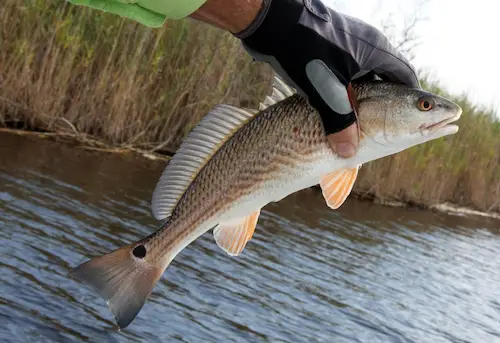
Many inshore redfish and speckled trout anglers use the popping cork rig as their go-to setup, especially in stained waters where the commotion caused by the popping cork helps fish to find the bait.
Fishing with a popping cork can also work well for other inshore species, such as flounder, snook and tarpon, since they also like to feed in shallow bays, lagoons and canals.
In addition, popping-cork rigs also catch other game fish, such as bluefish, cobia, and spanish mackerel, though these species are less frequently caught with this setup.
Incidental catches may include any saltwater species that feed in shallow coastal waters at one time or another.
Can you use a popping cork rig for bass?
Yes, you can use a popping cork for bass when they are chasing bait fish at the surface. The sound of the popping cork resembles the sound of baitfish jumping out of the water, and this can be great for attracting bass.
When using a popping cork for bass, it’s usually best to rig a small tube jig or soft plastic bait under the popping cork. Try to match the size, shape and color of the bait to the fish that the bass are keyed in on, and also experiment using flies when dealing with finicky bass.
However, if you find that the bass want to eat the popping cork itself, instead of your bait, it’s better to switch to a topwater lure, as you’ll get more successful hookups that way.
What is the best popping cork to use?
While there are many good popping corks on the market, here is a selection of my favorite ones:
- Cajun Thunder Popping Cork
- Bomber Paradise Popper
- Boat Monkey Popper
- DOA Popper Clacker
- Red Alert Speck-a-nater
- Blabber Mouth Popping Cork
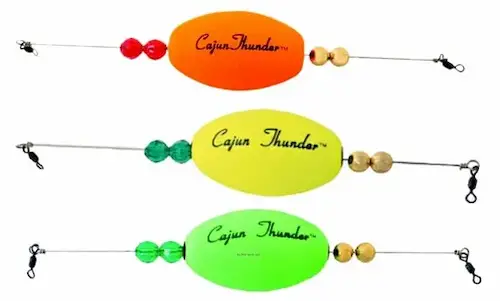
Any of these popping corks will catch fish for you, and if you’re targeting average sized redfish, you don’t need to worry too much about which brand you get, since even a cheap popping cork will get the job done.
However, if you’re going to be targeting big bull red drum, choosing the right popping cork becomes much more important.
For big bull reds, go for popping corks that have a thick, bendable wire, since that enables the cork to handle a lot of punishment without getting bent out of shape.
Sometimes redfish will try to eat the cork instead of the bait, and sometimes even sharks try to eat it, which is why you need a really sturdy cork to handle all of that rough treatment.
Also, when targeting big bull reds, go for the popping corks with bigger beads and heavier sinkers, and with swivels at both ends of the cork.
Where should you use a popping cork rig?
A popping cork rig is generally best for sport fishing in shallow inshore waters between 1 and 6 feet.
When fishing this depth, you can set your leader length to present your bait between the bottom and the middle of the water column, which is usually the prime strike zone for fish such as redfish and speckled trout.
The best places to use a popping cork rig are shallow bays, coves, inlets, grass flats, mud flats, estuaries, and creeks. You can also use them around piers, docks and jetties.
If you want to target redfish in deeper water, a better setup to use is the Carolina rig setup for redfish.
